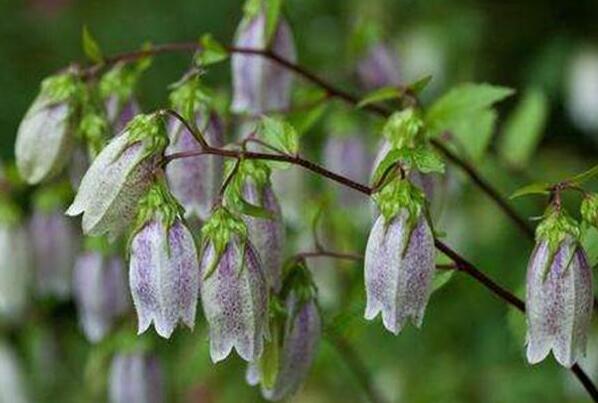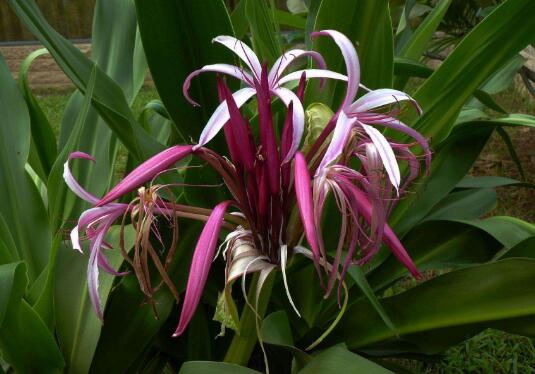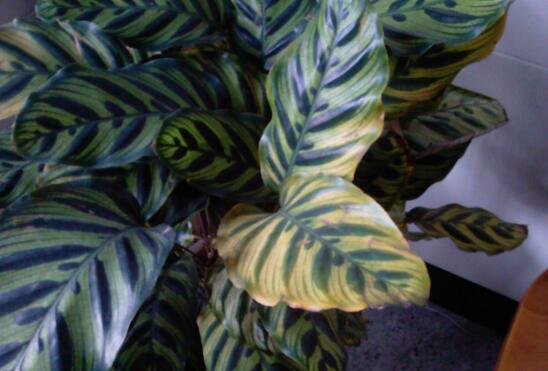Disease and pest control methods of Campanula, prevention and treatment skills of two insect pests / two diseases
Wind bell grass worms or disease spots are not what any flower friends want to see, but in order to avoid plants from being infested by pests and germs, in addition to mastering the breeding methods of bluebells, we also need to do a good job of prevention and treatment. at present, the main diseases and insect pests are aphids, red spiders, powdery mildew, leaf spot disease, the following is to learn about these common bluebell plant disease and insect pest control methods.
Control methods of diseases and insect pests of Campanula
1. Aphids

Flower lovers may have heard of aphids, because it is one of the most harmful plants in the world, most plants will become the targets of it, and the main injured parts are buds and leaves, because the sap is absorbed by aphids, causing leaves to curl and deform, which has a great impact on beauty.
Prevention and treatment: can be sprayed with a variety of drugs, such as 25% fish rattan essence EC diluted 800 times, 40% speed killing EC 800-1000 times, and so on. After killing aphids, it is necessary to do a good job in usual maintenance and management to keep the humidity not too high, not too much watering and so on.
2. Red spider
As one of the pests as famous as aphids, red spider is also a very common pest in the pest control of bluebells. It also feeds on juice. If it is not treated in time, it will cause leaves to fade and atrophy, and may also cause other diseases.
Prevention and control: spraying with 1000-fold solution of dimethoate, or using 800-1000-fold solution of thistle to control, once a week, 3-4 times can eliminate red spiders. After that, it is necessary to ensure that the temperature is above 30 degrees, because red spiders are easy to appear in high temperature environment.
3. Powdery mildew
Belong to the disease caused by fungi, the main harm parts are leaves, flower stalks, flower buds, flower buds and so on, there will be a layer of white powder mold on the surface of the leaves, and finally turn into a gray mold layer, and in serious cases, the plant will become short and the leaves will wither and curl.
Prevention and treatment: 50% carbendazim wettable powder can be sprayed 800-1000 times, or 70% methyl thiophanate wettable powder can be used. Spraying should pay attention to rational fertilization, not only nitrogen fertilizer but the importance of phosphorus and potassium fertilizer should be ignored.
4. Leaf spot
The disease spot on the leaf appears as if it had been soaked in water, and then the disease spot will turn dark brown, and there will be a concentric wheel texture alternating with light and dark, and a yellow halo will appear on the periphery, which will eventually lead to wilting of bluebells, branch deformities and even death.
Prevention and treatment: use 14% ammonia copper solution 350-500 times liquid spray, the time is once every 7-10 days, 2-3 times. In addition, we also need to avoid stagnant water when watering, do not frequently spray water to the leaf surface so that the humidity is too high, can reduce the risk of leaf spot disease.
The Flower language of bluebells Culture methods of bluebells
Bluebells, also known as bell flowers, originated in southern Europe, stout plants, bell-shaped flowers like wind chimes, the following will tell you about the flowers of bluebells and the breeding methods of bluebells.
The flower words of bluebells:
1. Most bluebells bloom in late spring and early summer, and the flowers and stamens are very small, with warm colors, and their flower words also imply health, tenderness and loveliness.
2. In order to commemorate the artistic talent of the Archbishop of Canterpari, in Italy, people born blessed by Campanula will have strong creativity and artistic temperament.
3. Distant blessings, love, eternal fetters, the wind gives beautiful blessings to the people in the heart, symbolizing the distant blessings in the name of the wind.
4. Be grateful and give to each other among friends to express the feeling of gratitude.
5. Jealousy comes from Greek mythology. It is said that the sun god Apollo liked bluebells very much, but the west wind threw a disc at his head because of jealousy, and the blood from the contact touched the ground, from which the flowers of bluebells blossomed. However, the flower language has been gradually forgotten by people.
Culture methods of bluebells:
1. Soil: bluebells like relaxed, fertile and well-drained loam.
2. Watering: bluebells should maintain a relatively high relative humidity before the radicle appears, and the substrate should also be relatively moist. If necessary, the newborn seedlings can be covered with a layer of coarse-grained vermiculite to moisturize.
3. Sunshine: bluebells like long sunshine, which can blossom naturally after 14 hours of sunshine every day. If you want to bloom ahead of time, you only need to break for 4 hours and deal with it in dark for 30 days.
4. Fertilization: if bluebells want to grow fast, they can apply 30 to 50PPM of calcium and nitrogen fertilizer, and then apply calcium fertilizer on the basis of it to make it grow fast.
5. Insect pests: the common diseases of bluebells are powdery mildew, leaf spot and rust, which can be sprayed with 1500 times diluted carbendazim wettable powder. Insect pests are mainly caused by aphids and thrips, which are sprayed with 40% omethoate EC diluted 1 500 times.
Bluebell grass-bluebell grass culture method | bluebell grass picture | bluebell grass, also known as bell flower, native to southern Europe, stout plant shape, bell-shaped flowers, bright and elegant flowers, very popular in Europe, is a common herbal flower in a small garden in late spring and early summer, often used to express health, tenderness and loveliness. Campanula is a biennial herb. The plant is about 1 m tall and hairy. Rosette leaves ovate to Obovate, margin crenate-undulate, scabrous. Petiole winged. Cauline leaves small and sessile. Racemes, 1 or 2 cauline florets. Corolla bell-shaped, 5-lobed, slightly dilated base, flowers are white, blue, purple and light pink and so on. Flowering from April to June. Culture methods of bluebells
1. Soil: bluebells like relaxed, fertile and well-drained loam.
2. Watering: bluebells should maintain a relatively high relative humidity before the radicle appears, and the substrate should also be relatively moist. If necessary, the newborn seedlings can be covered with a layer of coarse-grained vermiculite to moisturize.
3. Sunshine: bluebells like long sunshine, which can blossom naturally after 14 hours of sunshine every day. If you want to bloom ahead of time, you only need to break for 4 hours and deal with it in dark for 30 days.
4. Fertilization: if bluebells want to grow fast, they can apply 30 to 50PPM of calcium and nitrogen fertilizer, and then apply calcium fertilizer on the basis of it to make it grow fast.
5. Insect pests: the common diseases of bluebells are powdery mildew, leaf spot and rust, which can be sprayed with 50% carbendazim wettable powder diluted 1 500 times. Insect pests are mainly caused by aphids and thrips, which are sprayed with 40% omethoate EC diluted 1 500 times.
How to grow Campanula
How to plant bluebells to grow exuberantly? Reproduction: to reproduce by sowing. When the seeds of bluebells are ripe, the plants can blossom the following year. If it is sown in cool autumn, most seedlings will not blossom until the end of spring in the third year.
Matrix: the porous matrix with good drainage performance is selected, and the temperature and light are lower in autumn and winter. This is especially important when the matrix dries slowly.
Ph value of matrix: 5.5-6.0
Moisture: make the substrate a little drier between two watering times, but don't wilt the bluebells due to lack of water.
Temperature: 58-60 °F (14-60 ℃) at night and 65-70 °F (18-21 ℃) during the day. When active root growth occurs, the night temperature can drop to 50-55 °F (10-13 ℃), and the low temperature can last until the market season.
How to raise the purple bells
1. Soil: Rabdosia mandshurica grows well on the loam with good drainage and rich in humus.
2. Watering: purple bells avoid waterlogging, so you can't water too much, but at high temperature, you should pay attention to spraying water.
3. Temperature: purple bells are cold-resistant and avoid extreme heat, so in summer, we should pay attention to move the purple bells to places with strong ventilation, and at the same time, we should also pay attention to spraying water to reduce the temperature.
4. Pruning: the seedling growth of Rabdosia angustifolia is faster and messy in the early stage, but it does not need to be pruned and will be adjusted slowly in the later stage.
The flower language of bluebells
1. Thank you
If you like this flower, you are a grateful person, and you will bear in mind the kindness given to you by others. But you are extremely ego, believe in your own feelings, a little indifferent to others, and care about the shortcomings of others, so that your friends dare not easily approach you, gradually isolated.
2. Jealousy
Bluebells, which appeared in Greek mythology, was loved by the sun god Apollo. The jealous west wind threw the disc at the head of the bluebells, and the blood spattered on the ground, and the flowers of the bluebells bloomed. Therefore, its fancy language is jealousy. Those who are blessed by this kind of flower have a strong desire for monopolization and hope that their lovers will be their own for 24 hours. However, this is likely to be counterproductive!
The function of bluebells
The function of bluebells: 1. Ornamental. Campanula is an annual flower, often used in flower beds, rock bamboo gardens or gardens in the border or edge planting, chic flowers, elegant and beautiful colors, the effect will be more beautiful when planted together, it is of great ornamental value.
The role of bluebells: 2, layout environment. The wind bell grass flower shape is unique, like the small bell, the design is fresh and elegant, if the potted plant layout environment, and sunflower can also be used as the main material, with ivy, sea gold sand, carnation basket insertion, the performance of vitality, prosperity of the happy atmosphere; purple chimney as the main flower, with white lily, flying swallow, Tianmen winter flower arrangement, will appear quiet and soft, no matter which kind of use at home has a very good beautification effect.
The function of bluebells: 3, medicinal. The role of ornamental and environmental layout of Campanula is not small, and it is not bad in medicine. Campanula mandshurica can be used as medicine, collected in summer and autumn, cleaned soil, chopped and dried. The taste is bitter and cold. It has the effect of clearing away heat and detoxification and relieving pain. it is often used for pharyngitis and headache.
Related encyclopedia
Pocket scale non-woven bag lantern bamboo shoots crab feet red rice note3ykk zipper ybs zipper mountain cherry climbing wall plum field decision tomorrow winter plum green pine watch omega Longine watch children's building blocks rhododendron roll stick fruit Annona
- Prev

What about the worms of Manjushri orchid? pest control of Wenshu orchid / 2 insect pests 2 diseases
In the process of cultivating Wenshu orchid, the last thing we want to encounter is the problem of diseases and insect pests, which do great harm to the plant, not only affect the ornamental, but also lead to plant death. What about the Manjushri bugs? How to do pest control in Wenshu orchid
- Next

What to do when the peacock taro grows, the disease and pest control of the peacock taro / pay attention to the leaf spot
The beauty of peacock bamboo taro lies not only in its evergreen leaves, but also in the pattern of peacocks on its leaves. In life, many people like to plant peacocks and taros at home, but for some reason, they will grow worms and get sick, so there is no appreciation at all. So, what should we do if the peacock and taro grow into worms?
Related
- Fuxing push coffee new agricultural production and marketing class: lack of small-scale processing plants
- Jujube rice field leisure farm deep ploughing Yilan for five years to create a space for organic food and play
- Nongyu Farm-A trial of organic papaya for brave women with advanced technology
- Four points for attention in the prevention and control of diseases and insect pests of edible fungi
- How to add nutrient solution to Edible Fungi
- Is there any good way to control edible fungus mites?
- Open Inoculation Technology of Edible Fungi
- Is there any clever way to use fertilizer for edible fungus in winter?
- What agents are used to kill the pathogens of edible fungi in the mushroom shed?
- Rapid drying of Edible Fungi

